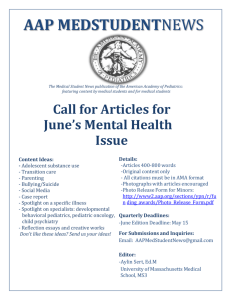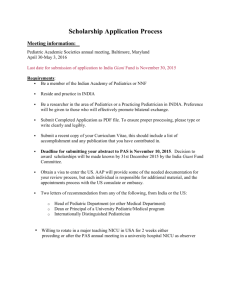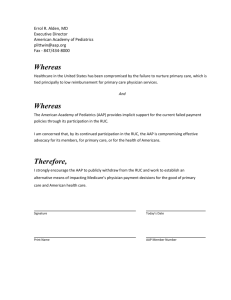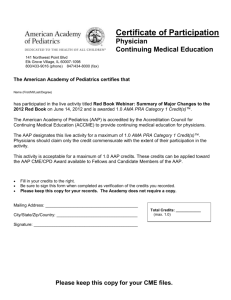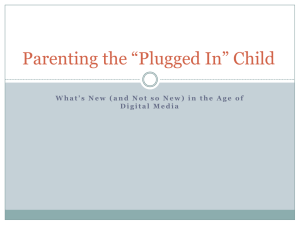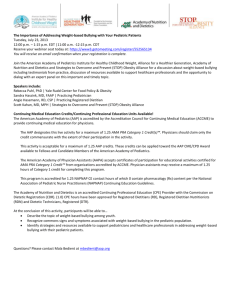What is a medical home? - Texas Department of State Health Services
advertisement
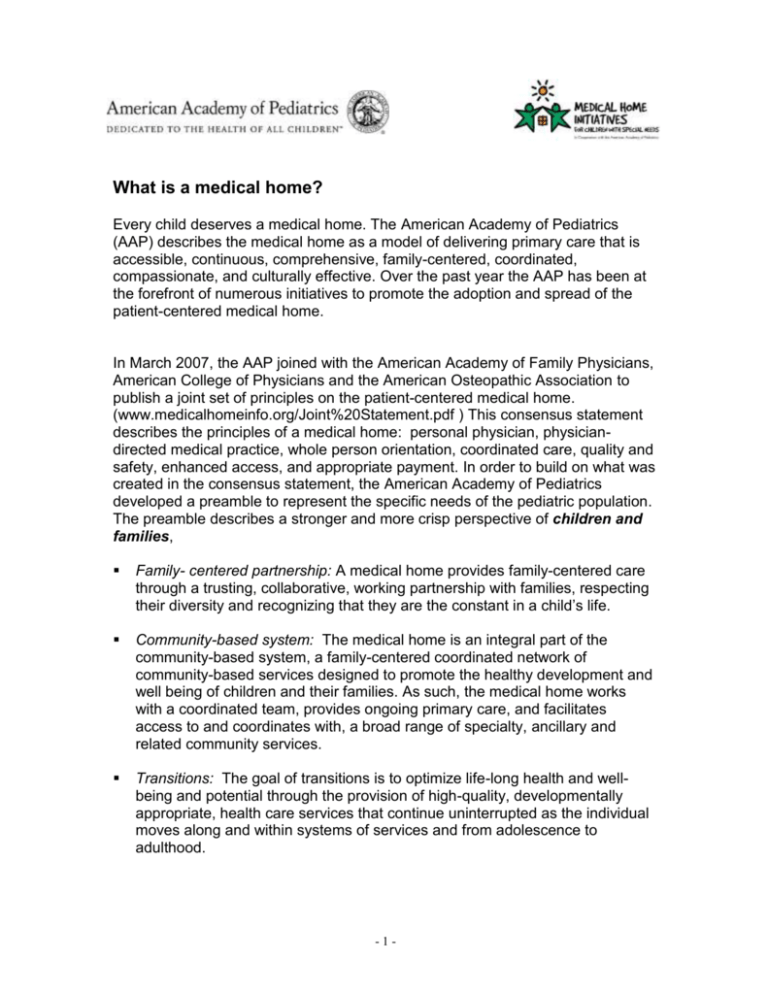
What is a medical home? Every child deserves a medical home. The American Academy of Pediatrics (AAP) describes the medical home as a model of delivering primary care that is accessible, continuous, comprehensive, family-centered, coordinated, compassionate, and culturally effective. Over the past year the AAP has been at the forefront of numerous initiatives to promote the adoption and spread of the patient-centered medical home. In March 2007, the AAP joined with the American Academy of Family Physicians, American College of Physicians and the American Osteopathic Association to publish a joint set of principles on the patient-centered medical home. (www.medicalhomeinfo.org/Joint%20Statement.pdf ) This consensus statement describes the principles of a medical home: personal physician, physiciandirected medical practice, whole person orientation, coordinated care, quality and safety, enhanced access, and appropriate payment. In order to build on what was created in the consensus statement, the American Academy of Pediatrics developed a preamble to represent the specific needs of the pediatric population. The preamble describes a stronger and more crisp perspective of children and families, Family- centered partnership: A medical home provides family-centered care through a trusting, collaborative, working partnership with families, respecting their diversity and recognizing that they are the constant in a child’s life. Community-based system: The medical home is an integral part of the community-based system, a family-centered coordinated network of community-based services designed to promote the healthy development and well being of children and their families. As such, the medical home works with a coordinated team, provides ongoing primary care, and facilitates access to and coordinates with, a broad range of specialty, ancillary and related community services. Transitions: The goal of transitions is to optimize life-long health and wellbeing and potential through the provision of high-quality, developmentally appropriate, health care services that continue uninterrupted as the individual moves along and within systems of services and from adolescence to adulthood. -1- Value: Recognizing the importance of quality health care, appropriate payment for medical home activities is imperative. A high-performance health care system requires appropriate financing to support and sustain medical homes that promote system-wide quality care with optimal health outcomes, family satisfaction, and cost efficiency. Why is medical home important now? As the best family-centered care… Medical home provides the best family-centered care in the best way appropriately utilizing limited resources with adequate payment for practice activities. As a remedy to high health care costs… The federal government recognizes the fact that the total health care costs for people with chronic disease account for more than 70% of the nation’s health care expenditures. Providing care in a medical home is thought to reduce the total cost of care. The Tax Relief and Health Care Act of 2006 provides funds for a Medicare Medical Home Demonstration Project, to be launched in 2010. How is the AAP involved in advocating for medical homes? In providing support for implementation of medical home activities… A medical home implementation toolkit and business plan are currently being developed for practices. In advocating for equitable payment for care… The AAP and the other primary care specialty societies recognize that implementation of the medical home requires a new approach to payment. The AAP is involved in the development and valuation of a code for care management that will be used to facilitate payment within the Medicare Medical Home Demonstration Project, scheduled to start in January 2009. The AAP has also brought together leaders to develop a strategy to achieve payment of services in the medical home. -2- In getting practices recognized as medical homes… The National Committee on Quality Assurance (NCQA) developed the Physician Practice Connections (PPC) module to identify and recognize physician practices that use information systematically to enhance the quality of patient care. There was firm agreement among all primary care specialty societies that the PPC is an appropriate platform on which to build standards and attributes that define a medical home. Additionally, this presents an opportunity to provide a uniform way of implementing the medical home concept. In order to assure that the PPC addressed the needs of children, the Academy developed recommendations for concrete changes to the PPC. With most of the AAP recommendations approved, the NCQA launched a new version of its PPC program in January 2008, titled the Physician Practice Connections - Primary Care Medical Home recognition program (PPC-PCMH) emphasizing the systematic use of patient-centered, coordinated care management processes. In getting health care plans to recognize the importance of medical home… Employer groups also have exhibited a strong interest in the PCMH model. The Academy, along with major national employer groups, health plans, and other medical specialty societies, is a partner in the Patient-Centered Primary Care Collaborative (PCPCC). (www.pcpcc.net) This coalition represents 50 million American workers and over 300,000 physicians. The coalition’s goals include working to stimulate additional medical home pilots by large, self-insured employer groups and fostering legislation that supports and encourages medical homes at the state and federal levels. As a member of the PCPCC, the Academy is providing leadership by serving on its Executive Steering Committee. In addition, senior AAP staff actively represents pediatric interests by participating on the advocacy, public payer, and private payer committees. Over the past year the Academy has met with major national health plans and employer groups to discuss implementation of the medical home model. To date the Academy has met with United HealthCare, Humana, and the BlueCross BlueShield Association. The Academy has brokered an understanding with United HealthCare that it will develop and test a separate pediatric version of the PCMH model. The Academy will continue to play a pivotal role in ensuring the interests of children, families and pediatricians are “front and center” as the medical home model continues to evolve in the private and public markets. Concrete next steps include the following: -3- Collaborate with the NCQA and the other primary care medical specialty societies in identifying markets and pediatric practices that can pilot test the PCMH. Continue to advocate for children as an active member of the steering committee for the Patient-Centered Primary Care Collaborative (PCPCC) Promote the joint principles and the accompanying preamble that qualifies the pediatric attributes to health plans, employers, and policy makers. Continue to work with United HealthCare, Humana, Aetna, CIGNA, WellPoint and Blue Cross Blue Shield, as well as other major national and regional health plans, to stake out other major health plans that are interested in examining the medical home model. Continue to advocate for firm and innovative payment mechanisms to support the medical home model; including the development and valuation of appropriate codes. Develop a specific medical home implementation plan with tools for medical home activities. Leverage the revised Bright Futures health supervision guidelines to build a connection to the PCMH. How can AAP support you in advocating or implementing medical home? National Center of Medical Home Initiative website www.medicalhomeinfo.org This is the premier resource for improving the lives of children and youth with special health care needs and their families through medical home. This website contains resources, state-specific links and information, and tools and practical strategies on how to provide medical homes. Nearly all materials are available free to download. Practice Management Online (PMO) http://practice.aap.org/ This is a resource for AAP members for the best pediatric practice management information, tools, and resources for pediatricians and their office staff in one easily accessible Web site. Medical home is a feature on this website, containing tools for practical use in implementing medical home. For more information, contact Trisha Calabrese at tcalabrese@aap.org Chapter Alliance for Quality Improvement (CAQI) This alliance helps AAP Chapters build the capacity to support the quality improvement work of medical homes. For more information, contact Vanessa Brown at vbrown@aap.org eQipp module The development of an eQipp module on medical home is being discussed within -4- the Academy to aid in satisfying the maintenance of certification requirements for 2010. Quality Improvement Innovation Network (QuINN) The AAP Quality Improvement Innovation Network (QuIIN) serves as a practical working lab for pediatricians to test how improvements can be implemented in everyday pediatric practice. For more information, email quiin@aap.org or visit the Web site at www.aap.org/moc/quiin. -5- AAP Chapters/Pediatric Councils Pediatric councils serve as forums to address pediatric issues with payers involving covered services, plan policies and payer administrative procedures with impact access, quality, and cost. For more information, contact Lou Terranova at lterranova@aap.org Further Questions? Contact: The National Center of Medical Home Initiatives for Children with Special Needs 800-433-9016 ext. 7621 Medical_home@aap.org Acronyms NCQA: PCPCC: PPC: PPC-PCMH: National Committee on Quality Assurance Patient Centered Primary Care Collaborative Physician Practice Connections Module Physician Practice Connections Primary Care Medical Home recognition program Bibliography American Academy of Pediatrics National Center of Medical Home Initiatives for Children With Special Needs www.medicalhomeinfo.org American Academy of Pediatrics; Medical Home Initiatives for Children With Special Needs Project Advisory Committee. The Medical Home (RE9262). Pediatrics. 2002;110(1):184-186. http://aappolicy.aappublications.org/cgi/content/full/pediatrics;110/1/184 American Academy of Pediatrics; Committee on Hospital Care. Family-Centered Care and the Pediatrician’s Role. Pediatrics 2003 112: 691-696. http://aappolicy.aappublications.org/cgi/content/full/pediatrics;112/3/691 American Academy of Pediatrics; Committee on Community Health Services The pediatrician’s role in community pediatrics. Pediatrics. 1999; 103(6):1304-1306. http://aappolicy.aappublications.org/cgi/content/full/pediatrics;103/6/1304 American Academy of Pediatrics, American Academy of Family Physicians, and American College of Physicians-American Society of Internal Medicine A Consensus Statement on Health Care Transitions for Young Adults With Special Health Care Needs. Pediatrics 2002 110: 1304-1306. http://aappolicy.aappublications.org/cgi/content/full/pediatrics;110/6/S1/1304 American Academy of Pediatrics; Council on Children With Disabilities. Care Coordination in the Medical Home: Integrating Health and Related Systems of Care for Children With Special Health Care Needs. Pediatrics 2005 116: 1238-1244. http://aappolicy.aappublications.org/cgi/content/full/pediatrics;116/5/1238 -6- Developed by: American Academy of Pediatrics Division of Children with Special Needs The National Center of Medical Home Initiatives for Children with Special Needs March 2008 -7-
